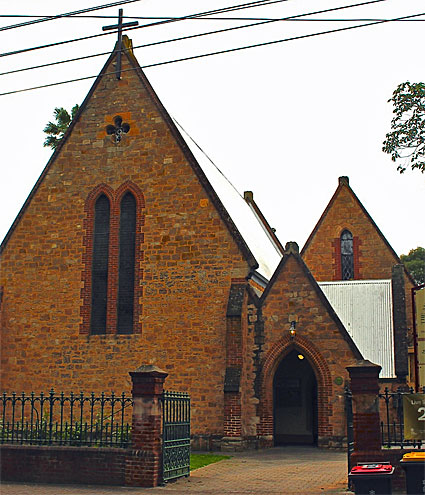
St Bartholomew's Anglican Church, Norwood: exterior
[Photograph by Trevor Bunning (1 October 2013)]

St Bartholomew's Anglican Church, Norwood: exterior
[Photograph by Trevor Bunning (1 October 2013)]
Historical and Technical Documentation by David Shield
© OHTA 2013 (last updated September 2013)
Both church and organ at St Bartholomew's Anglican Church in Norwood remain faithful to the original. The church, planned in 1855, was to be constructed in three stages, aisle, nave and chancel. With minor dimensional changes and the addition of vestry and porch this was complete by 1898. The organ, purchased in 1896 is the first to have been built by J.E. Dodd in his own right. Apart from being moved to the new chancel it too remains as originally designed.
Building the church began in October 1855. A meeting was held in the library of St Peter's College to discuss the draft trust deed and appoint a building Committee. Charles T. Hargrave, architect, submitted designs for the church in complete and temporary form:
… to consist of a nave measuring 56 ft. 6 in. by 26 ft., with a side-aisle 45 by 17 ft., a chancel 16 ft. square, and a porch 10 ft. by 6 ft.; the style to be early English, and the total cost £2.000. At present he proposes to erect only the aisle, which will accommodate 144 persons, and cost, with the necessary fittings, about £450.1
The proposal was approved but action was to be delayed until after harvest when prices were expected to be more moderate. Tenders were called in July the following year with the first services on Sunday 21 June 1857.
Tenders for construction of the nave were sought five years later. Added to the west side of the aisle the building was 67 feet in length, slightly longer than the original plan, and the height to the ridge was 45 feet. It was consecrated on Thursday evening 23 October 1863.
During the service the choir chanted several of the responses, assisted by the organist of the church Mr. Heberlet2, on the harmonium, and the anthem 'Awake, awake' was also performed by them.3
At some point an American organ replaced the harmonium. In November 1895 a vestry meeting decided steps should be taken for it too to be replaced. The current pipe organ by J.E. Dodd was to be the result.

St Bartholomew's Anglican Church, Norwood: organ
[Photograph by Trevor Bunning (1 October 2013)]
J.E. Dodd had become the owner of the business of Fincham & Hobday in South Australia on payment of the sum of £1200 in July 1894. Under Arthur Hobday the firm had commenced in August 1881 with Dodd as his employee. Hobday never really settled to life in Adelaide, and sought ways to wind up the business on occasion. He early recognised Dodd's work ethic and skill as a mechanical organ builder.4 In 1888 he returned to Melbourne leaving Dodd sole manager. The work of the firm over the next six years may be attributed to Dodd. While no completely new instruments were constructed several were rebuilt or extended. The organ for St Bartholomew's was the first built by the firm of J.E. Dodd.
Because of the time involved it is suggested the organ was a speculation by J.E. Dodd, a model of his potential. Having resolved to replace the American organ it is assumed a representative of St Bartholomew's contacted Dodd in December for a quotation. Dodd duly responded with perhaps a variation the same month or early in 1896. In February it was announced that the congregation had resolved "to purchase the sweet toned oragon (sic) lately built by Mr Dodd of this City…"5 Soon after we find Dodd writing to E.H. Bleby about an opening date.6 The chancel and organ were opened 28 March 1896 with organist W.J.P. Taylor at the instrument. The organ was located in the north-western corner of the church.
A full description was given in the Press.
The new instrument was built by Mr. E.J. Dodd (sic) at the Twin-street Organ Factory, and contains two manuals and an independent pedal organ. The compass of the manual is CC to G, fifty-six notes, and that of the pedals CCC to F, thirty notes. The entire instrument is constructed in accordance with the rules and recommendations of the Royal College of Organists, London. The following are the stops:— Great organ open diapason, metal, 8 ft.; claribel, wood, 8 ft.; dulciana, metal, 8 ft.; principal, metal. 4 ft.; and wald flute, wood, 4 ft. The swell organ contains— Open diapason, metal. 8 ft.; gedact, wood, 8 ft.; gemshorn, metal, 4 ft.; piccolo, metal, 2 ft; and oboe, metal 8 ft. Pedal organ— Bourdon, wood, 16 ft. There are the usual three couplers, swell pedal, and two composition pedals to the great organ. The case is of pine stained to a dark walnut colour and varnished. The pipe front consists of two handsome towers supported by massive carved brackets with a flat of pipes arranged in symmetrical order between them. This front has been richly decorated in gold and colours principally soft shades of brown and grey, which give the instrument a very handsome and attractive appearance. The tone is rich and full, and the instrument unusually powerful for an organ of this size.7
Several features are of particular interest. William Chudleigh undertook the decoration mentioned. Chudleigh was recognised as one of the most expert signwriters, gilders, and embossers in the colony. After working with H.L. Vosz for 19 years he established a large business connection on his own account. This work would have been one of his last commissions as he died in July 1896 after an illness of some seven weeks.8
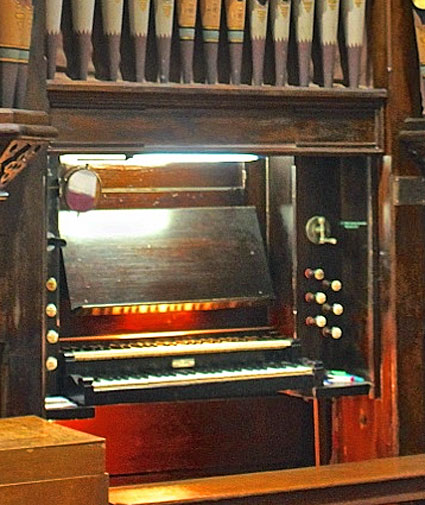
St Bartholomew's Anglican Church, Norwood: console
[Photograph by Trevor Bunning (1 October 2013)]
The trigger swell was the last to be constructed by J.E. Dodd. All new instruments that followed, with that at St Ignatius Catholic Church being the first, had a balanced swell pedal.
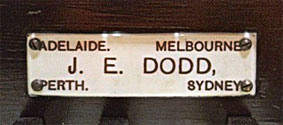
St Bartholomew's Anglican Church, Norwood: nameplate
[Photograph by Trevor Bunning (1 October 2013)]
The nameplate is also of interest. It reads Adelaide Perth and Melbourne. While he had attempted to set up an agency in West Australia in 1894, the agreement with Fincham was that neither could build instruments in the other's area for a period of 10 years from that date.9 As Dodd claimed on occasion to have been established from 1881, this is seen as an advertising ploy to promote his business.
Comments in the newspaper indicate a departure from the tonal structure previously employed by Fincham & Hobday. The stops were referred to as full cathedral scale,10 and particular note was made of the open diapason.
Probably the best stop is the open diapason on the great organ, which is very full and powerful throughout the whole of its compass, and shows a great advance on previous stops of this class constructed by an Adelaide firm. The wald flute and claribel are also very successful specimens of their order, the claribel being full and even in quality and the flute an excellent imitation of the orchestral instrument.11
Two years later the final stage of the original plan, the Chancel was built. Not designed originally to accommodate a pipe organ its dimensions were enlarged.
The structure, which is of freestone faced with brick harmonising with the church building, measures 24 ft. x 26 ft., and embraces an organ chamber 13 ft. by 9 ft. 9 in.12
Mr S.T.C. Best, a catechist with the church, must have contacted Dodd seeking the cost of moving the organ.13 The quote being acceptable the move was duly undertaken.
The church has a number of interesting stained glass windows. As outlined in Donovan,14 they are as follows:
1a Angel appearing to the three Marys
1b Christ & Mary Magdalen
This window, made by Ward & Hughes (1866) was presented to the church by Mr. Frederick Norman Scarfe in memory of his wife, who had died in England the year before. Register 27/11/1866 p.2
2 Suffer Little children (1934)
A memorial window to her parents was provided for in the will of Mrs. Mary Ann Cordeaux 1934. Advertiser 12/6/1934 p.4
3 Nativity Napier Waller (1938)
The window and a chalice to the memory of Elizabeth Charlotte Wall were dedicated in November 1938 Advertiser 19/11/1938 p.23
4 Light of the World H.L. Vosz (c.1914)
Canon Andrews resigned in 1914 after a rectorship of 40 years, and a window (Holman Hunt's 'light of the World') to commemorate the event was subscribed for by the parishioners. Mail 30/6/1917 p.13
5 Good Shepherd, Clarkson Ltd, (1936)
A window in memory of Elizabeth Hitchen Advertiser 10/10/1936 p.15
6a Commissioning of St Peter
6b Christ
6c St John the Baptist
Made by W. Wailes 1872 and previously located in St Peter's Cathedral and now the main east window. The construction of the nave coincided with the removal of two windows in St Peter's Cathedral, when the lady chapel was added. One of which was offered to St Bartholomew's. Register 17/11/1900 p.6
7 Crucifixion Napier Waller (1941)
8a Magdalen anointing Christ
8b Christ Speaking to Martha
Both Ward & Hughes 1888. Mr: Charles C. Scarfe in 1888 presented the window in memory of his wife. Register 22/1/1889 p.5
9 St George Heaton Butler & Bayne
10 St Alban Heaton Butler & Bayne
The story of the church bell appeared in the Chronicle of Thursday 9 May 1929.
The original bell of St. Bartholomew's, Norwood, cost £30, which was collected in threepences by Mrs. Nicholls, sister of Mrs. Henry Watts. It was damaged in 1918, and recast. When it was decided to have a new bell, negotiations were opened with a Melbourne secondhand dealer, who sold them a bell weighing 5½ cwt. for £50. It was afterwards ascertained that the bell was the one used by the first volunteer fire brigade in the City of Melbourne. This bell, which is believed to have been made by Mears and Stainbank, was sold by the fire brigade to the dealer. Some surprise was expressed that this relic of old Melbourne should have been allowed to leave the city.
| GREAT Open Diapason Claribel Dulciana Principal Wald Flute Swell to Great SWELL Open Diapason Gedact Gemshorn Piccolo Oboe PEDAL Bourdon Swell to Pedal Great to Pedal |
8 8 8 4 4 8 8 4 2 8 16 |
Compass 56/30
balanced swell pedal
trigger tremulant
2 composition pedals to Great
attached drawstop console
located in chamber to north of chancel
1 Register 26/10/1855 p2
2 James William Heberlet arrived in Adelaide in 1853 and gave music lessons in several ladies schools. Youngest son of the second in command of the old East India Company, he held the position of organist in several city and suburban churches of various denominations. He died in June 1910. Register 29/6/1910 p.6
3 Register 23/10/1863 p.2
4 Fincham & Hobday Letters, 12/76 12 July 1883 Hobday to Fincham p.80
5 Church News v.1 n.14 February 28 1896 p.6
6 Unfortunately the correspondence of Dodd is unavailable. The comments and assumptions are based on a pagination index produced by B.A. Naylor for his thesis research which shows correspondence with the St Bartholomew's organ committee regarding quotation for 1895 (p.368) and 1896 (p.370) and query as to opening date to Bleby (p.382). Although precise dates are not given, because the page numbers are sequential it has been assumed they occurred after 19 November 1895 and before March 30 1896.
7 Register 30/3/1896 p.6
8 Advertiser 22/7/1896 p.5; ibid 23/7/1896 p.6
9 Indenture of Fincham Hobday with J.E. Dodd in Naylor B.A., Organ Building in South Australia, vol. II pp.484-488
10 Advertiser 30/3/1896 p.7
11 Register 30/3/1896 p.6
12 Register 1/3/1901 p.6
13 J.E.Dodd letters 1898-1903, p.348 (1901) noted by BAN
14 Donovan, P. & J., A Guide to Stained Glass Windows in and about Adelaide, 1983, pp.52-4

St Bartholomew's Anglican Church, Norwood: detail of pipe decoration
[Photograph by Trevor Bunning (1 October 2013)]
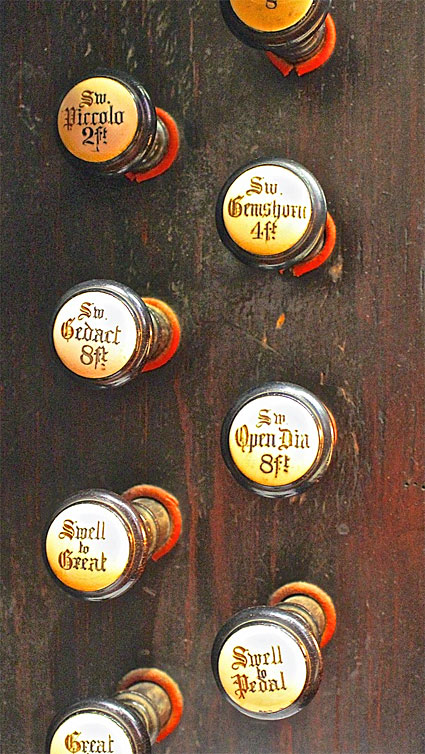
St Bartholomew's Anglican Church, Norwood: left-hand stop jamb
[Photograph by Trevor Bunning (1 October 2013)]
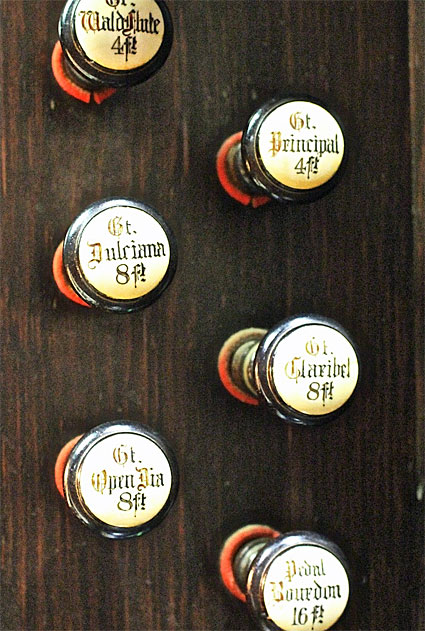
St Bartholomew's Anglican Church, Norwood: right-hand stop jamb
[Photograph by Trevor Bunning (1 October 2013)]
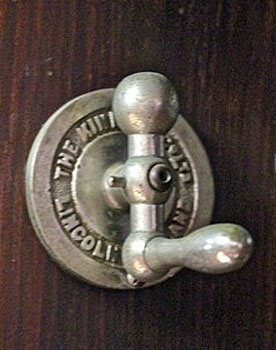
St Bartholomew's Anglican Church, Norwood: hydraulic blowing control
The Kinetic Co., Ltd., Lincoln, England
[Photograph by Trevor Bunning (1 October 2013)]